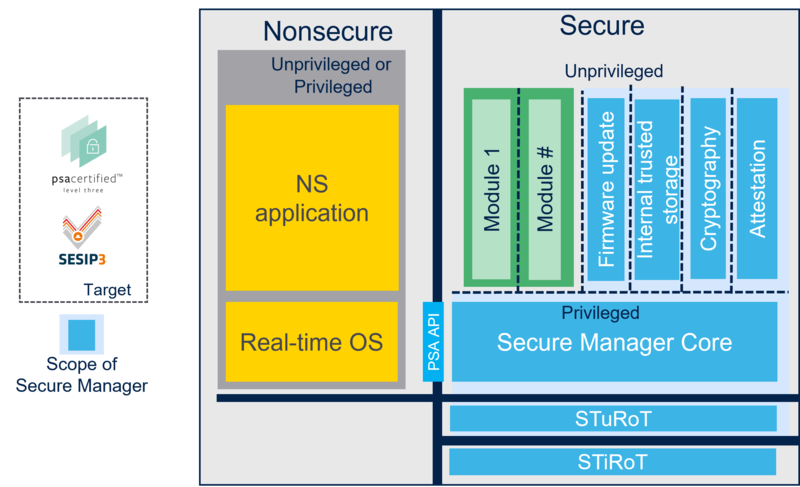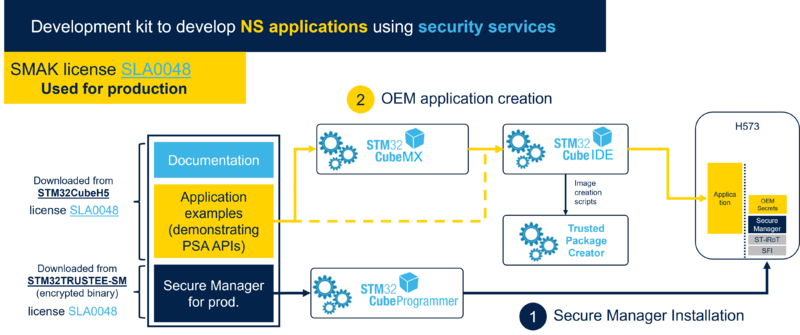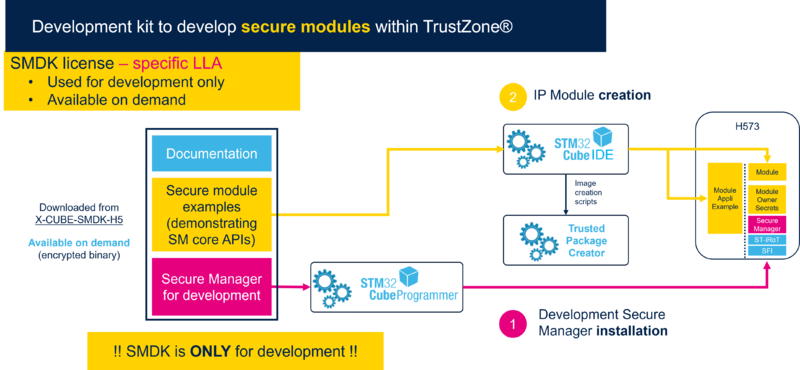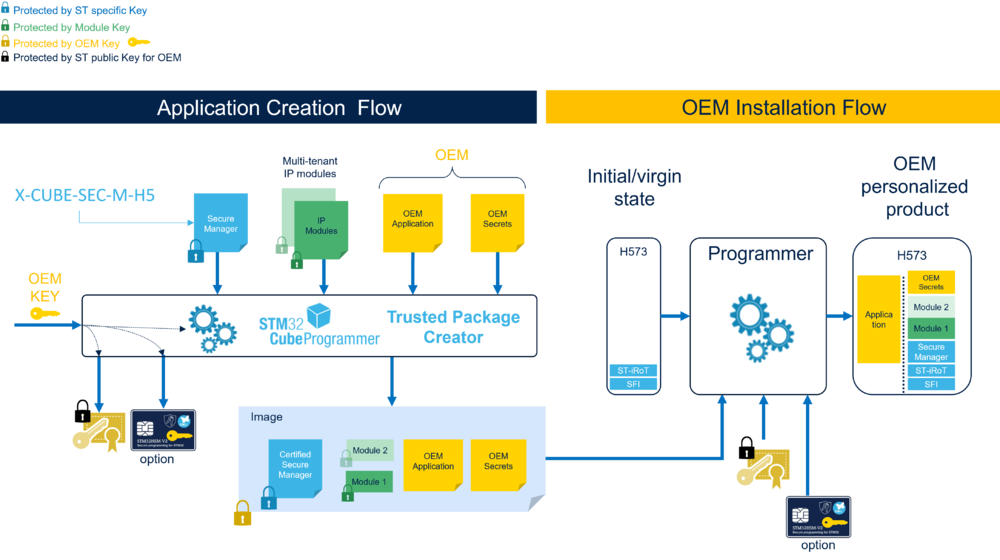1. What is the Secure Manager ?
The Secure Manager is an STMicroelectronics trusted execution environment security framework that is compliant with Arm® Platform Security Architecture (PSA) specifications for Cortex®-M (Armv8-M).
The Secure Manager is aiming at simplifying the security development cycle of embedded applications by providing ready to use security services developed according to best practices.
It is linked to our STM32Cube ecosystem and made easy to be installed within our selected STM32 devices.
The Secure Manager is targeting a certification based on PSA level 3 and SESIP3.
Easy to be installed into STM32 products by the customers on their production lines, the Secure Manager offers a ready-to-use, high-performance, and certification target solution to support the Secure Boot, root of trust, cryptography, internal trusted storage, initial attestation, and firmware update functions as defined by the Arm® PSA specifications.
Main features are:
- Arm PSA standard and API compliancy
- Arm PSA services
- Secure Boot
- Cryptography
- Internal trusted storage
- Initial attestation
- Firmware Update
- Multiple-tenant software IP protection
- Sandboxed secure services (PSA isolation level 3)
- Security certification target
- PSA certification target L3
- GlobalPlatform SESIP3
2. Secure Manager overview
The Secure Manager is executed in secure processing environment (SPE).
It is composed of the SMiRoT, SMuRoT, Secure Manager Core and Secure Services.
It is responsible for Secure Boot and Secure Firmware Update, and it provides secure services to nonsecure (NS) applications at runtime.
The Secure Manager is composed of:
- A 2-level Root of Trust
- An immutable Root of Trust (SMiRoT)
- An updatable Root of Trust (SMuRoT)
- The Secure Manager Core
- Secure Services such as
- Cryptography
- Initial attestation
- Trusted storage
- Firmware update
Additionally, trusted applications, also called secure modules, can be added by the user, but are not part of the Secure Manager.
The following figure describes the Secure Manager architecture.
2.1. Secure Manager components
2.1.1. Immutable Root of Trust (SMiRoT)
The immutable Root of Trusted named further SMiRoT is responsible for the first stage secure boot and secure firmware update.
The following firmware can be updated:
- SMuRoT
During update, integrity, authenticity and confidentiality are covered.
For more details, go to STiRoT article.
2.1.2. Updatable Root of Trust (SMuRoT)
The updatable Root of Trusted named further SMuRoT is responsible for the second stage secure boot and secure firmware update.
The following firmware can be updated:
- Non-secure application
- Secure Manager (Secure Manager Core and secure services)
- Secure modules (updatable independently from the Secure Manager)
During the update, the integrity, authenticity and confidentiality is ensured.
2.1.3. Secure Manager Core
The Secure Manager Core (SM Core) is responsible for supporting the following secure core services:
- Isolation between non-secure application and Secure Manager (using TrustZone®)
- Isolation between secure services (using MPU)
- Communication between non-secure application and secure services, and between secure services themselves (using inter-processor communication - IPC)
- Interrupt handling
- Scheduling of secure services and interrupts
The Secure Manager Core is also responsible for multiple-tenant software IP protection.
It is implemented as a secure service that is protected from other software (non-secure application, secure services) using full sandboxing (PSA L3 isolation).
The IP protection is also ensured when the software is installed and updated, thanks to the Secure Firmware Update function.
To develop proprietary secure services, the Secure Manager Core supplies PSA API and extensions.
These APIs are used by a secure service to communicate with others secure services, or to access hardware resources.
2.1.4. Secure services
The Secure Manager is responsible for supplying secure services at runtime. These services can be used by non-secure applications and other secure services.
The following services are supported:
- PSA cryptography: it supplies cryptographic services such as authentication or encryption, based on hardware cryptographic acceleration and side-channel resistance.
- PSA internal trusted storage: it supplies services for storing in internal flash memory the most important assets (such as key and data), ensuring integrity, authenticity, and confidentiality. To be noticed that ITS storage is encrypted.
- PSA attestation: it supplies services to authenticate a device. To do this, a signed token is generated for each device, which is later authenticated by a server.
- PSA firmware update: it supplies services to download new firmware images and perform image update.
2.1.5. Secure modules or trusted applications
A secure module (also named trusted application) is a secure service that can be implemented by an OEM. For this purpose, a secure module development kit (SMDK) is available.
To be noticed that a secure module is installed and updated independently from the Secure Manager image.
2.2. Secure Manager functions
2.2.1. Configurability
The Secure Manager can be configured during the installation phase using parameters selected by the OEM, such as the non-secure application installation key, the number of modules, and the ITS storage size.
2.2.2. Security functions
The Secure Manager supports the following STM32Trust security functions:
- Secure Boot
- Secure Firmware Install/Update
- Silicon device life cycle
- Isolation
- Secure Storage
- Cryptography
- Secure manufacturing
- Attestation
- Software IP protection
- Abnormal situation handling
Refer to stm32trust/security functions[1] for the definition of the security functions.
3. Secure Manager ecosystem
The Secure Manager is delivered with an ecosystem used to handle its life cycle.
This ecosystem is composed of:
- The Secure Manager access kit (SMAK): used to develop non-secure applications using Secure Manager services
- The secure module development kit (SMDK): used to develop secure modules and associated APIs to access these modules from non-secure applications.
3.1. Secure Manager access kit (SMAK)
The SMAK provides the environment to develop non-secure application that uses the Secure Manager services.
It is composed of:
- X-CUBE-SEC-M-H5 Expansion Package, available from st.com (STM32TRUSTEE-SM[2]):
- Secure Manager (encrypted images, one per profile), delivered under the SLA0048 software license agreement. It can be used for production purposes.
- Templates and examples to develop a non-secure application
- Scripts to provision and install the Secure Manager
- STM32 Trusted Package Creator to build signed and encrypted images
- STM32CubeProgrammer [3] to program signed and encrypted images
- Integrated development environments (IDEs)
The following figure presents the SMAK ecosystem.
3.2. Secure module development kit (SMDK)
The SMDK provides the environment for developing secure modules.
The SMDK is composed of:
- X-CUBE-SEC-M-H5 Expansion Package, containing the ecosystem to provision and install the Secure Manager
- X-CUBE-SMDK-H5, available for each device supporting the Secure Manager, including
- The SMDK Secure Manager binary with secure trace capabilities (UART trace). It must be used for development purposed only.It is available under a signed license agreement - Contact your ST representative.
- An example of a secure module running inside the SPE
- An example of a nonsecure application running inside the NSPE and interfacing with the above secure module
- A secure module template
- Associated documentation
The following figure presents the SMDK ecosystem.
3.3. Ecosystem for manufacturing
During the manufacturing preparation and installation flow:
- OEM gets the encrypted Secure Manager image from STMicroelectronics
- OEM gets the encrypted secure module image from module owner
- OEM prepares the encrypted firmware image composed of:
- The nonsecure application image
- The OEM secrets and above Secure Manager
- The secure module images
- OEM installs the whole images
The following figure describes the Secure Manager manufacturing preparation and installation flow.
4. Further information
For details on Secure Manager for STM32H5, please see Secure Manager for STM32H5 article.
5. Acronyms and definitions
See Security acronyms and definitions article.
6. References
Platform Security Architecture (PSA)
PSA Security Model



